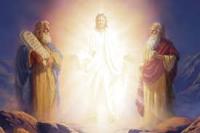
The scene recounted by Luke in today’s gospel is a picture of God’s plan of salvation in miniature. Jesus and his disciples went up a mountain, an image of nearness to God. Elijah entered a cave at Mount Horeb and encountered God in the gentle breeze (1 Kings 19:12-13). Moses received the Ten Commandments on Mount Sinai, probably the same as Mount Horeb (Exodus 20:1-24). Jesus was seen by the disciples meeting these two great figures in the history of Israel, the Prophet and the Law-Giver. With Jesus in the centre, the New and the Old Covenants were brought seamlessly together.
Unlike Matthew and Mark, Luke relates how the three people were speaking of Jesus’ journey to Jerusalem. God’s plan was being made apparent. Peter in particular was overcome by the spectacle, and wanted to make three booths for Jesus, Moses and Elijah. It may have been the time of this Jewish autumn festival, which recalls the time when the Jews lived in tents in the desert. Perhaps the symbolism here is that God rescued his people and brought them to the Promised Land. In Jesus he would bring them to something much greater: everlasting life.
Peter and the disciples would have liked to remain fixed in that place with Jesus in His glory, but they would have to face reality and come to terms with the fact that God’s ways are not ours. The vision, however, would sustain them through the crucifixion and death of their Lord.